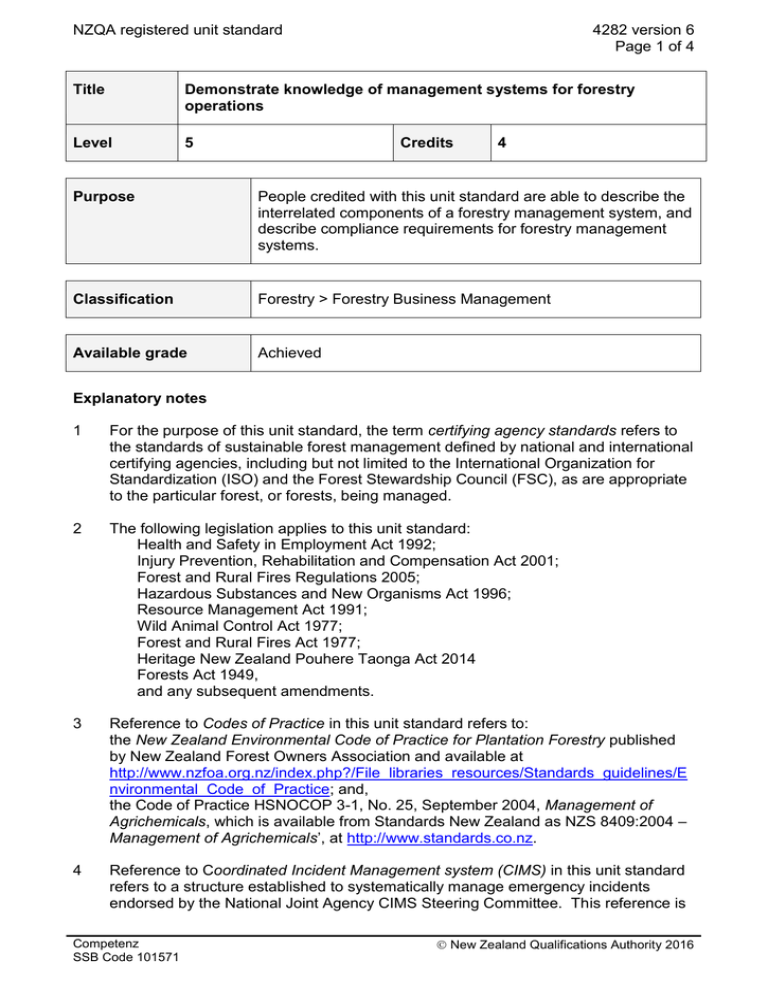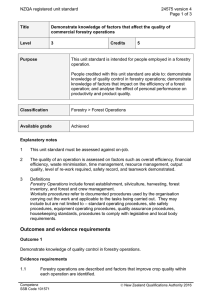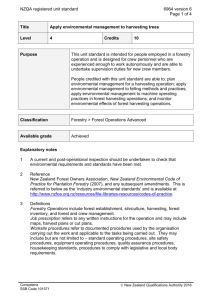NZQA registered unit standard 4282 version 6 Page 1 of 4
advertisement

NZQA registered unit standard 4282 version 6 Page 1 of 4 Title Demonstrate knowledge of management systems for forestry operations Level 5 Credits 4 Purpose People credited with this unit standard are able to describe the interrelated components of a forestry management system, and describe compliance requirements for forestry management systems. Classification Forestry > Forestry Business Management Available grade Achieved Explanatory notes 1 For the purpose of this unit standard, the term certifying agency standards refers to the standards of sustainable forest management defined by national and international certifying agencies, including but not limited to the International Organization for Standardization (ISO) and the Forest Stewardship Council (FSC), as are appropriate to the particular forest, or forests, being managed. 2 The following legislation applies to this unit standard: Health and Safety in Employment Act 1992; Injury Prevention, Rehabilitation and Compensation Act 2001; Forest and Rural Fires Regulations 2005; Hazardous Substances and New Organisms Act 1996; Resource Management Act 1991; Wild Animal Control Act 1977; Forest and Rural Fires Act 1977; Heritage New Zealand Pouhere Taonga Act 2014 Forests Act 1949, and any subsequent amendments. 3 Reference to Codes of Practice in this unit standard refers to: the New Zealand Environmental Code of Practice for Plantation Forestry published by New Zealand Forest Owners Association and available at http://www.nzfoa.org.nz/index.php?/File_libraries_resources/Standards_guidelines/E nvironmental_Code_of_Practice; and, the Code of Practice HSNOCOP 3-1, No. 25, September 2004, Management of Agrichemicals, which is available from Standards New Zealand as NZS 8409:2004 – Management of Agrichemicals’, at http://www.standards.co.nz. 4 Reference to Coordinated Incident Management system (CIMS) in this unit standard refers to a structure established to systematically manage emergency incidents endorsed by the National Joint Agency CIMS Steering Committee. This reference is Competenz SSB Code 101571 New Zealand Qualifications Authority 2016 NZQA registered unit standard 4282 version 6 Page 2 of 4 available from http://www.civildefence.govt.nz/resources/new-zealand-coordinatedincident-management-system-cims-2nd-edition/ 5 Definition Accepted industry practice – approved codes of practice and standardised procedures accepted by the wider forestry industry as examples of best practice. Worksite procedures refer to documented procedures used by the organisation carrying out the work and applicable to the tasks being carried out. They may include but are not limited to – standard operating procedures, site safety procedures, equipment operating procedures, quality assurance procedures, housekeeping standards, procedures to comply with legislative and local body requirements. Outcomes and evidence requirements Outcome 1 Describe the interrelated components of a forestry management system. Evidence requirements 1.1 Forest management policy development is described in terms of factors that influence policy development. Range 1.2 Standards in the forest industry are described in terms of how they influence forest management policy. Range 1.3 organisation management policy, levels of authority and delegation, span of control, location of work operations. Procedures for monitoring and reporting achievement in key performance areas in the forest industry are described in terms of identifying issues and continuous improvement. Range 1.5 Acts and regulations, Regional and District Plans, Codes of Practice, industry best practice, certifying agency standards. Factors that influence the allocation of decision-making responsibilities are described in terms of their impact on assigning responsibility to individuals. Range 1.4 factors include – industry best practice, organisation strategy, market requirements, certifying agency standards. identifying non-compliance, assessing procedure effectiveness and efficiency, improving provision of information and application. Procedures for audit of performance against set targets and standards are described in terms of the benefits these procedures can bring to the business. Competenz SSB Code 101571 New Zealand Qualifications Authority 2016 NZQA registered unit standard Range 1.6 4282 version 6 Page 3 of 4 internal evaluation of performance against standards to meet certification requirements, external evaluation to measure system provision, compliance and organisational efficiency. Corrective action processes and revision of procedures and standards of performance are described in terms of the benefits these processes and procedures can bring to the business. Range revision where performance fails to meet prescribed standards, revision where performance standards are changed. Outcome 2 Describe compliance requirements for forestry management systems. Evidence requirements 2.1 The health and safety management requirements for forestry management systems are described in accordance with Acts, regulations and Codes of Practice. Range 2.2 The fire protection management requirements for forestry management systems are described in accordance with Acts, regulations and Codes of Practice. Range 2.3 Forest and Rural Fires Act 1977, Hazardous Substances and New Organisms Act 1996, Forest and Rural Fires Regulations 2005, CIMS, worksite procedures. The environmental management requirements for forestry management systems are described in accordance with Acts, regulations and Codes of Practice. Range 2.4 Health and Safety in Employment Act 1992, Approved Code of Practice for Safety and Health in Forest Operations 1999, Injury Prevention, Rehabilitation, and Compensation Act 2001, worksite procedures. Resource Management Act 1991, Forests Act 1949, Wild Animal Control Act 1977, the Heritage New Zealand Pouhere Taonga Act 2014, Hazardous Substances and New Organisms Act 1996, Regional Plans, District Plans, Resource Consents, Codes of Practice, worksite procedures. The quality management requirements for forestry management systems are described in terms of setting and monitoring quality compliance standards. Range Competenz SSB Code 101571 customer requirements, product value, forest health and sustainability, standards required by accredited quality systems, worksite procedures. New Zealand Qualifications Authority 2016 NZQA registered unit standard Planned review date 4282 version 6 Page 4 of 4 31 December 2020 Status information and last date for assessment for superseded versions Process Version Date Last Date for Assessment Registration 1 7 August 1995 N/A Review 2 27 May 1998 N/A Review 3 27 May 2002 N/A Review 4 16 October 2009 N/A Revision 5 16 July 2010 31 December 2017 Review 6 10 December 2015 N/A Consent and Moderation Requirements (CMR) reference 0173 This CMR can be accessed at http://www.nzqa.govt.nz/framework/search/index.do. Please note Providers must be granted consent to assess against standards (accredited) by NZQA, before they can report credits from assessment against unit standards or deliver courses of study leading to that assessment. Industry Training Organisations must be granted consent to assess against standards by NZQA before they can register credits from assessment against unit standards. Providers and Industry Training Organisations, which have been granted consent and which are assessing against unit standards must engage with the moderation system that applies to those standards. Requirements for consent to assess and an outline of the moderation system that applies to this standard are outlined in the Consent and Moderation Requirements (CMR). The CMR also includes useful information about special requirements for organisations wishing to develop education and training programmes, such as minimum qualifications for tutors and assessors, and special resource requirements. Comments on this unit standard Please contact Competenz at qualifications@competenz.org.nz if you wish to suggest changes to the content of this unit standard. Competenz SSB Code 101571 New Zealand Qualifications Authority 2016




